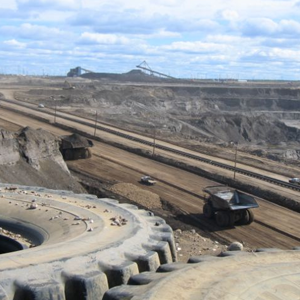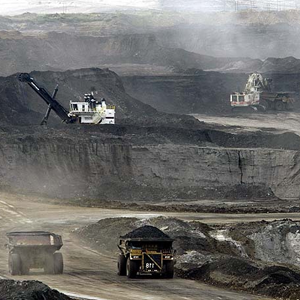OIL SANDS
OIL SANDS :
Alberta's oil sands contain the largest known reserve of oil in the world. An estimated 1.7 to 2.5 trillion barrels of oil are trapped in a complex mixture of sand, water, and clay. The most widely accepted theory of how this vast reserve was formed suggests that light crude oil from southern Alberta migrated north and east under the same pressures that shaped the Rocky Mountains.
Over time, the actions of streams and bacteria transformed the light crude into bitumen, a much denser, carbon-rich, and highly viscous oil. The concentration of bitumen in oil sands can range from 1% to 20%. The oil-soaked sand deposits remain from ancient rivers in three main areas: Peace River, Cold Lake, and Athabasca. The Athabasca region is the largest and closest to the surface, accounting for the extensive oil sands development around Fort McMurray.
Dr. Karl Clark, a scientist working for the Alberta Research Council, developed and patented the hot water extraction system. Building on previous experiments by Sidney Ells and others, which utilized hot water to separate oil from oil sands, Dr. Clark's work brought the process to a commercial scale.

Oil sand is mixed with hot water to create a slurry. Early techniques used large tumbler drums to form the slurry. Today, hydrotransport pipelines are used to form and transfer the oil sand from the mine to the extraction plant. The slurry is later fed into a separation vessel where it separates into three layers - sand, water, and bitumen. The bitumen is then skimmed off the top to be cleaned and further processed.
WHERE ARE OIL SANDS MINED?
Oil sands mining takes place in several countries worldwide, including Canada, Venezuela, and the United States. In Canada, oil sands mining occurs primarily in the provinces of Alberta and Saskatchewan. The majority of mining operations are concentrated in the Athabasca Oil Sands region of northern Alberta, which boasts the world's largest known reserves of oil sands. This area is characterized by extensive deposits of bitumen, a dense, viscous oil found within the sand.
The process of oil sands mining entails extracting bitumen from the ground and subsequently processing it to produce oil. Typically, this involves strip mining, wherein the top layer of soil and rock is removed to expose the bitumen deposits. Specialized equipment is then used to extract the bitumen, which is subsequently transported to an upgrader for processing into synthetic crude oil.
PROCESS OF OILSANDS:
1. Mining: Heavy earth-moving equipment is used to extract oil sands from deposits and transport them to an extraction facility.
2. Separation: The oil sand is crushed and mixed with hot water and caustic soda at a processing facility. This mixture is then passed through a series of separation vessels where the heavier bitumen separates from the lighter sand and water.
3. Extraction: Bitumen is extracted from the oil sand using a process called "hot water extraction." This involves adding hot water and caustic soda to the bitumen and mixing it together. The hot water causes the bitumen to separate from the sand and other materials.
4. Upgrading: The bitumen undergoes treatment with heat and chemicals at an upgrading facility to remove impurities and produce synthetic crude oil.
5. Refining: The synthetic crude oil is transported to a refinery where it undergoes further processing into various products, including gasoline, diesel, and lubricants.
TYPES OF OIL SANDS :
Oil sands, a type of unconventional petroleum deposit found in sand and rock formations, consist of a mixture of clay, sand, water, and bitumen—a heavy, viscous form of petroleum. Oil sands can be categorized into two types:
1. Bitumen-in-Place (BIP) Oil Sands: These deposits contain trapped bitumen that is not readily accessible. To recover the bitumen, miners must first remove the overburden—the layer of sand, clay, and rock covering the bitumen. Once exposed, the bitumen is extracted using mechanical or thermal extraction methods.
2. Bitumen-in-Solution (BIS) Oil Sands: These deposits feature bitumen suspended in liquid form. Typically found at shallow depths, BIS oil sands are more easily accessible than BIP deposits. Conventional drilling methods are employed to recover the bitumen, which can then be processed and refined into various products, including gasoline, diesel, and asphalt.
USES OF OIL SANDS :
Oil sands are abundant in specific regions worldwide, notably in Canada, Venezuela, and the United States. Typically comprising sand, clay, water, and bitumen—a dense, viscous form of petroleum—oil sands also contain a natural blend of hydrocarbons, salts, minerals, and trace metals like nickel, copper, and vanadium.
The formation of oil sands is a complex process influenced by geological, physical, and chemical factors. It begins with the accumulation of organic matter from plants and animals in shallow seas or lakes. Over millions of years, as these deposits amass, they undergo increasing pressure and heat, eventually transforming into bitumen. This bitumen becomes buried deeper underground, eventually forming oil sands deposits.
Oil sands must be mined and processed to extract the bitumen, as it does not occur naturally in a liquid state. The mining and processing of oil sands involve a combination of techniques to extract the valuable bitumen from the sand and clay mixture.
As oil sands play an increasingly vital role in the global energy supply, it's essential to comprehend their formation and composition to maximize their potential as a valuable energy resource.










